With the discovery of the Dead Sea Scrolls shortly after World War II, a lot of %%writings were found near the Dead Sea in a Jewish collection of manuscripts, perhaps a library, if you will, and many of these documents are called pseudepigrapha. Now what are the pseudepigrapha? They’re about a hundred writings, between sixty-three and one hundred writings that are sacred to many Jews and it’s very important to realize that the canon was not closed; so a lot of Jews, and followers of Jesus, would consider these sacred scripture.
I think it’s very important to recognize that although pseudepigrapha literally means “false writings,” these are not false in any way. The authors who brought together sacred traditions recognized that they were inspired by people like Enoch and Elijah and Isaiah and, therefore, they would put that title, not their own name and I like this very much. It’s not right for me to put my name on a book or for any modern author to put our names on a book. That seems more false to me than recognizing who influenced me.
If you really want to be read, you put someone’s name like Enoch or Isaiah on the writing and you can talk about being inspired.—“I had a dream and a vision”—we would say, intensively studying Isaiah, “I come to the conclusion.” It’s very different and it’s their way of honoring those that inspired them.


